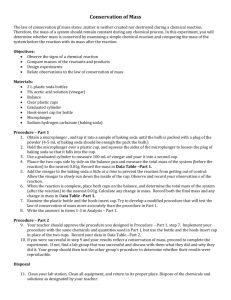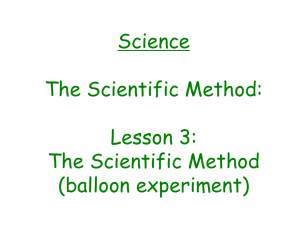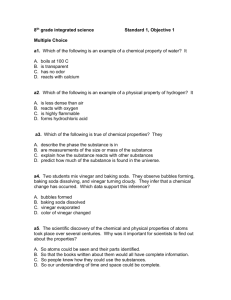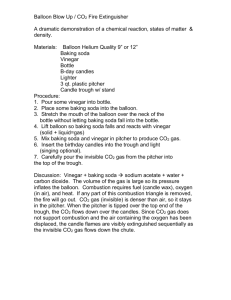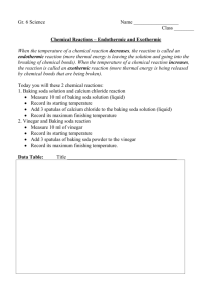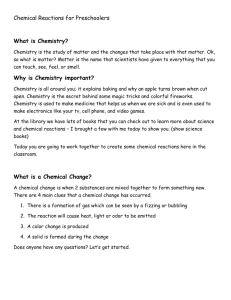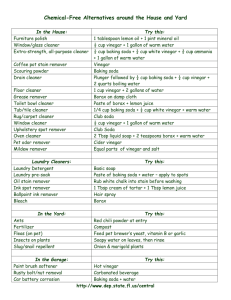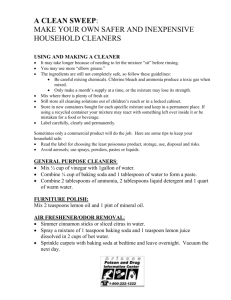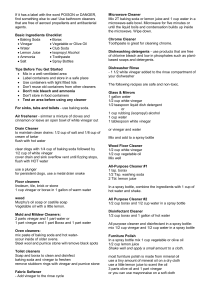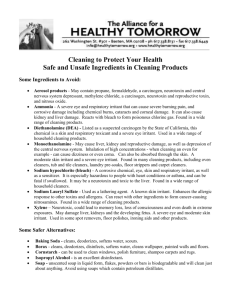Measurium Project: Gas Released from a Reaction
advertisement
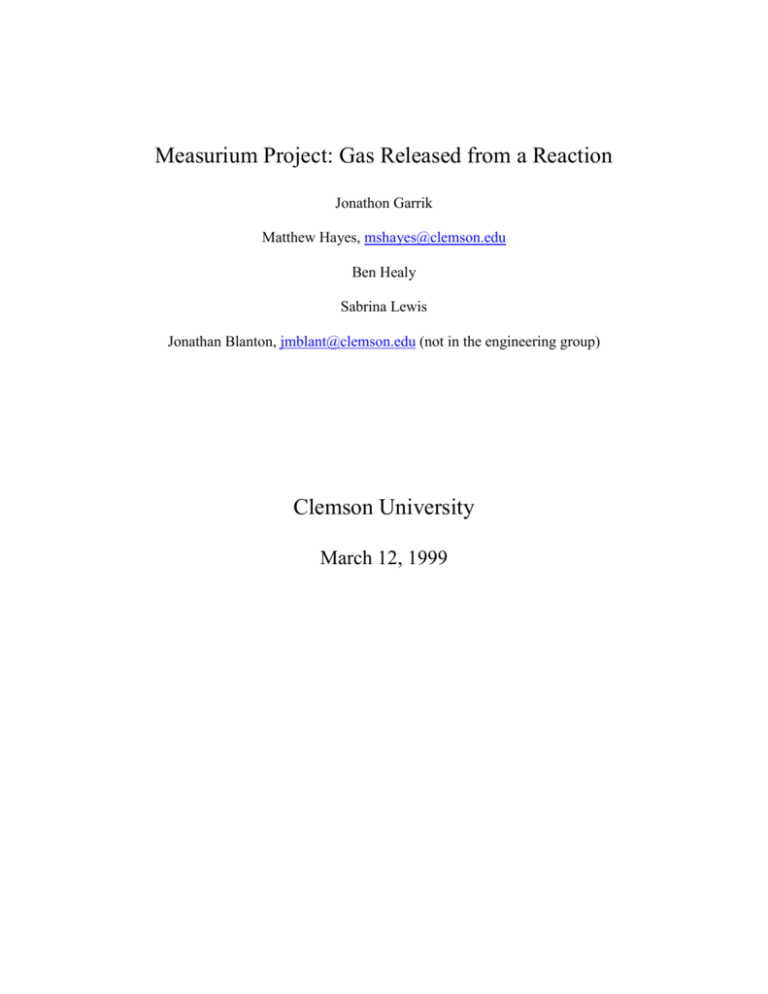
Measurium Project: Gas Released from a Reaction Jonathon Garrik Matthew Hayes, mshayes@clemson.edu Ben Healy Sabrina Lewis Jonathan Blanton, jmblant@clemson.edu (not in the engineering group) Clemson University March 12, 1999 Abstract The problem at hand is to find the amount of gas released by a reaction of baking soda and vinegar. An introduction of the problem is discussed along with the results of the experiment used to find the answer to the given problem. The design and setup of the experiment process is also talked about. Graphs will help interpret the results and data found. The known amount of gas released by a reaction is helpful when attempting chemistry problems or in a situation where it is important to know how much CO2 is given off by the addition of baking soda to vinegar. While finding the amount of gas released a device was developed not only for this one reaction but can also be used for other reactions that have a gaseous product. A ratio was found and a device was constructed that is able to make accurate measures of gas released. Introduction In chemistry some reactions produce gas as a product or gas is released in some manner. One such reaction is the mixture of baking soda and vinegar. Vinegar mixed with baking soda will cause bubbling and frothing which indicates gas being released from the reaction. The gas released from the reaction is in some unknown amount. Knowing the amount of gas released by reaction may be pertinent in several situations in which some people come across. Such a need would be to fill a balloon up with the gas given off by the reaction between baking soda and vinegar. The amount of gas is necessary to fill the balloon to its needed volume. A device must be created in order to measure the amount of gas that is being given off. The device should measure the volume of gas in and give a reasonable set of data from previous experiments. If the data is in accordance with itself then it can be assumed that the device functions properly. Previous experiments performed in early childhood showed several different ways of carrying out the experiment. Some of those experimental apparatus’ were filling a balloon with air and measuring the volume of it, or allowing the reaction to take place in a container with a top that when the pressure of the gas builds up the top flies a certain height. From that height an equation was developed to give the amount of gas released. That known information helped develop the apparatus and method used in the experiment yet to be described. If measured correctly the results can be set up into a ratio for any that desire to do continuing research in this particular field. Methods/Materials Apparatus for Measurium Project: Water bottle with water Funnel Straw Orange Cup The object of study was the amount of gas released by the reaction. In order to measure the volume of gas an apparatus was constructed (shown in the above diagram). The materials used in the experiment were a bucket, two plastic bottles, straw, and water. The materials were chosen based on immediate availability and cost efficiency. The procedures chosen were based on what was thought to be the most efficient method with the materials at hand. Filling the water bottle to the top with water started the experiment. The cap was then placed on top to keep the water inside so it wouldn’t spill when the bottle was inverted and placed in the bucket of water. Once the bottle was in the bucket of water, the cap was removed, but the water stayed in the bottle because the pressure in both systems was equal. Once the lid was removed, we were able to place the straw from the orange cup into the mouth of the water bottle. A measured amount of baking soda was placed into the cup and the lid was closed. A measured amount of vinegar was then poured in through the funnel that was fitted into a hole that was cut on the lid of the cup. When the vinegar was poured into the funnel and had gone completely through the funnel, the hole was plugged temporarily with a sharpened pencil. When the vinegar reached the bottom of the cup, it reacted with the baking soda and produced a gas. The only outlet from the cup was the red straw, so the gas traveled through the straw and into the water bottle pushing out enough water to make room for the gas that was produced. A line was then marked on the outside of the water bottle to indicate how much water was evacuated from the system. From this, we were able to fill the bottle up to the line with water, measure the volume of water therefore measuring the volume of gas that had been produced. As with any project or experiment, there is going to be error. We tried to compensate for loss of gas by taping the holes around the straw and the funnel in the lid of the orange cup. But, even with the holes taped and the hole of the funnel plugged, there was probably still some loss of gas. Another thing that could have caused some error was the size of the cup in which we performed the reaction. The “orange cup” had a pretty large area, probably a little less than two liters. Because of the large area a lot of the gas produced probably stayed in the cup because there was no need for it to escape. The area was large and the pressure in the cup was low, so we weren’t able to measure the gas that stayed in the cup. The loss of gas in the experiment due to these two “errors” was minimal and probably did not effect our results by a large degree. Baking Soda and Vinegar Data S, soda(mL) 20 10 10 10 10 10 10 10 8 4 4 0 V, vinegar(mL) 100 100 125 150 175 200 70 50 40 40 70 0 G, gas(mL) 425 650 750 1090 1730 1925 270 150 80 60 210 0 G/(V+S) 3.54167 5.90909 5.55556 6.8125 9.35135 9.16667 3.375 2.5 1.66667 1.36364 2.83784 0 SUMMARY OUTPUT Regression Statistics 0.786882684 Multiple R R Square 0.619184358 Adjusted R Square 0.581102794 Standard Error 4.028042506 Observations 12 Coefficients Standard Error t Stat P-value 3.343939389 2.095837351 1.595515 0.14168132 1.620060919 0.401771148 4.032298 0.00239066 Intercept X Variable 1 RESIDUAL OUTPUT Observation 1 2 3 4 5 6 7 8 9 10 11 Predicted Y 9.081655144 12.91702664 12.34427783 14.3806044 18.49369825 18.19449781 8.811644991 7.394091687 6.044040921 5.553113369 7.941409565 Residuals -4.081655144 -2.917026638 0.155722172 0.6193956 -0.993698254 1.805502186 -1.811644991 -2.394091687 -1.044040921 4.446886631 9.558590435 V/S 5 10 12.5 15 17.5 20 7 5 5 10 17.5 0 12 3.5 -3.343939389 Dimensionless Plot 25 20 V/S 15 10 5 0 0 2 4 6 8 10 G/(V+S) Dimensional Plot Gas Produced From 10mL of Baking Soda and Variable Amounts of Vinegar 2000 gas produced, G (mL) 1750 1500 1250 1000 750 500 250 0 0 50 100 150 volume of vinegar, V (mL) 200 250 Results The experiment provided the information needed to develop a ratio and with that ratio a number of possible questions was answered. The graphs on the following pages show the ratio between the amount of gas and the reactants of the solution. With the information now provided a hypothetical question such as if you have x amount of vinegar and y amount of baking soda how much gas will be formed from the potential reaction? From the data found the conclusion is that the reaction depends more on the amount of baking soda than the amount of vinegar. Without performing the experiment any person with the information from this report will be able to give a reasonable estimate of the volume of gas released by the reaction.

